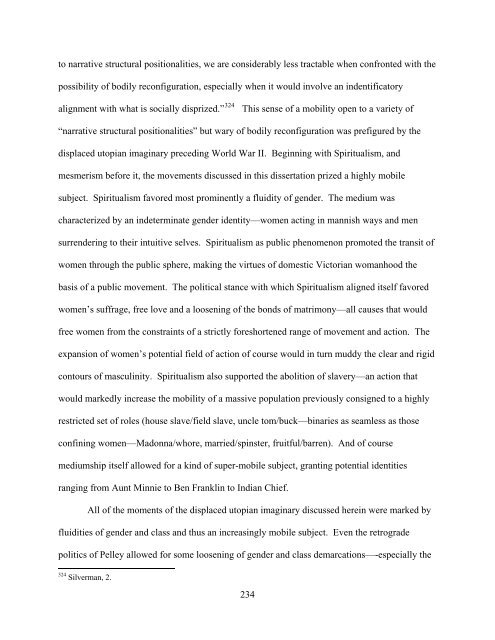A Genealogy of the Extraterrestrial in American Culture
A Genealogy of the Extraterrestrial in American Culture
A Genealogy of the Extraterrestrial in American Culture
You also want an ePaper? Increase the reach of your titles
YUMPU automatically turns print PDFs into web optimized ePapers that Google loves.
to narrative structural positionalities, we are considerably less tractable when confronted with <strong>the</strong><br />
possibility <strong>of</strong> bodily reconfiguration, especially when it would <strong>in</strong>volve an <strong>in</strong>dentificatory<br />
alignment with what is socially disprized.” 324<br />
This sense <strong>of</strong> a mobility open to a variety <strong>of</strong><br />
“narrative structural positionalities” but wary <strong>of</strong> bodily reconfiguration was prefigured by <strong>the</strong><br />
displaced utopian imag<strong>in</strong>ary preced<strong>in</strong>g World War II. Beg<strong>in</strong>n<strong>in</strong>g with Spiritualism, and<br />
mesmerism before it, <strong>the</strong> movements discussed <strong>in</strong> this dissertation prized a highly mobile<br />
subject. Spiritualism favored most prom<strong>in</strong>ently a fluidity <strong>of</strong> gender. The medium was<br />
characterized by an <strong>in</strong>determ<strong>in</strong>ate gender identity—women act<strong>in</strong>g <strong>in</strong> mannish ways and men<br />
surrender<strong>in</strong>g to <strong>the</strong>ir <strong>in</strong>tuitive selves. Spiritualism as public phenomenon promoted <strong>the</strong> transit <strong>of</strong><br />
women through <strong>the</strong> public sphere, mak<strong>in</strong>g <strong>the</strong> virtues <strong>of</strong> domestic Victorian womanhood <strong>the</strong><br />
basis <strong>of</strong> a public movement. The political stance with which Spiritualism aligned itself favored<br />
women’s suffrage, free love and a loosen<strong>in</strong>g <strong>of</strong> <strong>the</strong> bonds <strong>of</strong> matrimony—all causes that would<br />
free women from <strong>the</strong> constra<strong>in</strong>ts <strong>of</strong> a strictly foreshortened range <strong>of</strong> movement and action. The<br />
expansion <strong>of</strong> women’s potential field <strong>of</strong> action <strong>of</strong> course would <strong>in</strong> turn muddy <strong>the</strong> clear and rigid<br />
contours <strong>of</strong> mascul<strong>in</strong>ity. Spiritualism also supported <strong>the</strong> abolition <strong>of</strong> slavery—an action that<br />
would markedly <strong>in</strong>crease <strong>the</strong> mobility <strong>of</strong> a massive population previously consigned to a highly<br />
restricted set <strong>of</strong> roles (house slave/field slave, uncle tom/buck—b<strong>in</strong>aries as seamless as those<br />
conf<strong>in</strong><strong>in</strong>g women—Madonna/whore, married/sp<strong>in</strong>ster, fruitful/barren). And <strong>of</strong> course<br />
mediumship itself allowed for a k<strong>in</strong>d <strong>of</strong> super-mobile subject, grant<strong>in</strong>g potential identities<br />
rang<strong>in</strong>g from Aunt M<strong>in</strong>nie to Ben Frankl<strong>in</strong> to Indian Chief.<br />
All <strong>of</strong> <strong>the</strong> moments <strong>of</strong> <strong>the</strong> displaced utopian imag<strong>in</strong>ary discussed here<strong>in</strong> were marked by<br />
fluidities <strong>of</strong> gender and class and thus an <strong>in</strong>creas<strong>in</strong>gly mobile subject. Even <strong>the</strong> retrograde<br />
politics <strong>of</strong> Pelley allowed for some loosen<strong>in</strong>g <strong>of</strong> gender and class demarcations—-especially <strong>the</strong><br />
324 Silverman, 2.<br />
234















